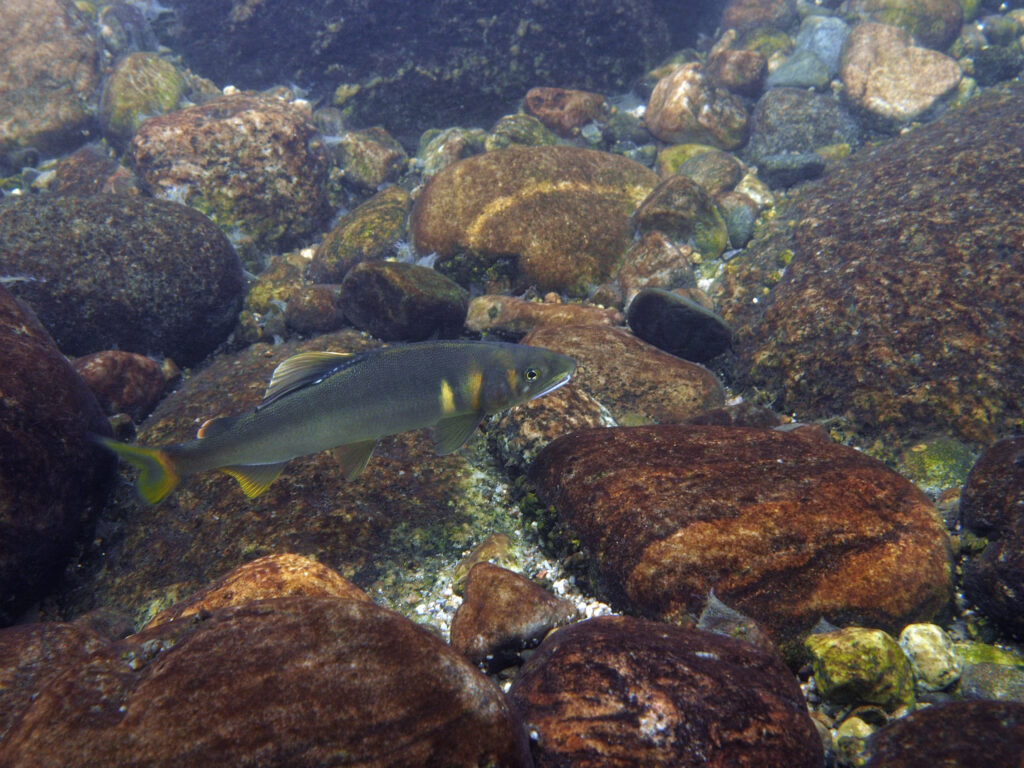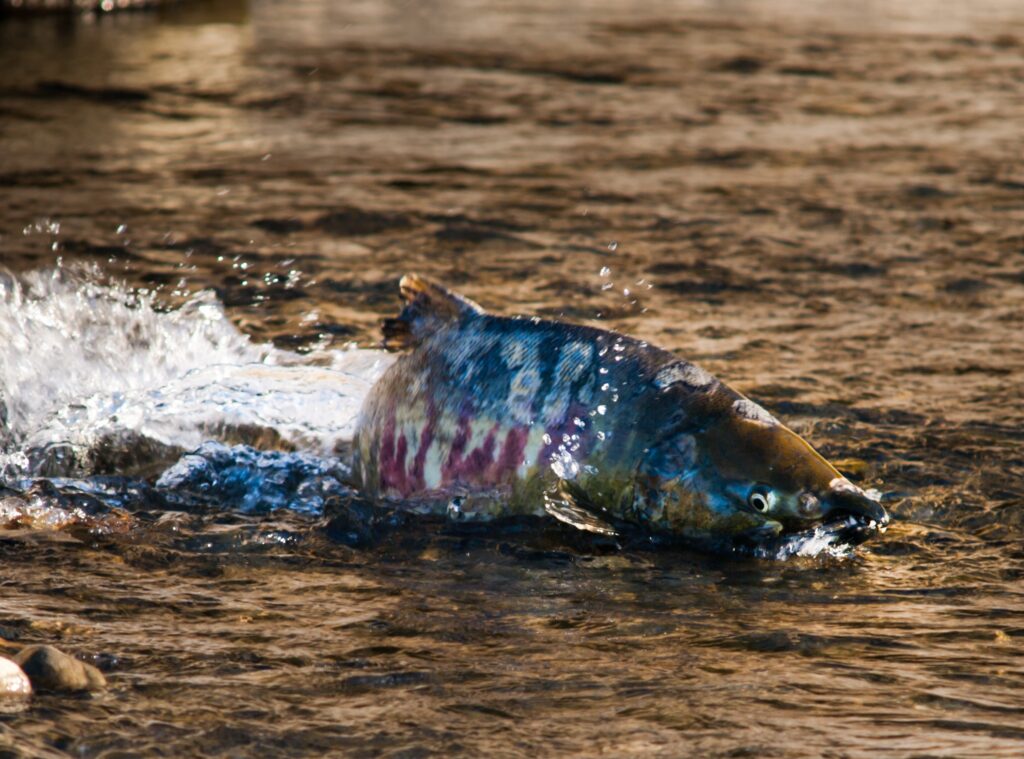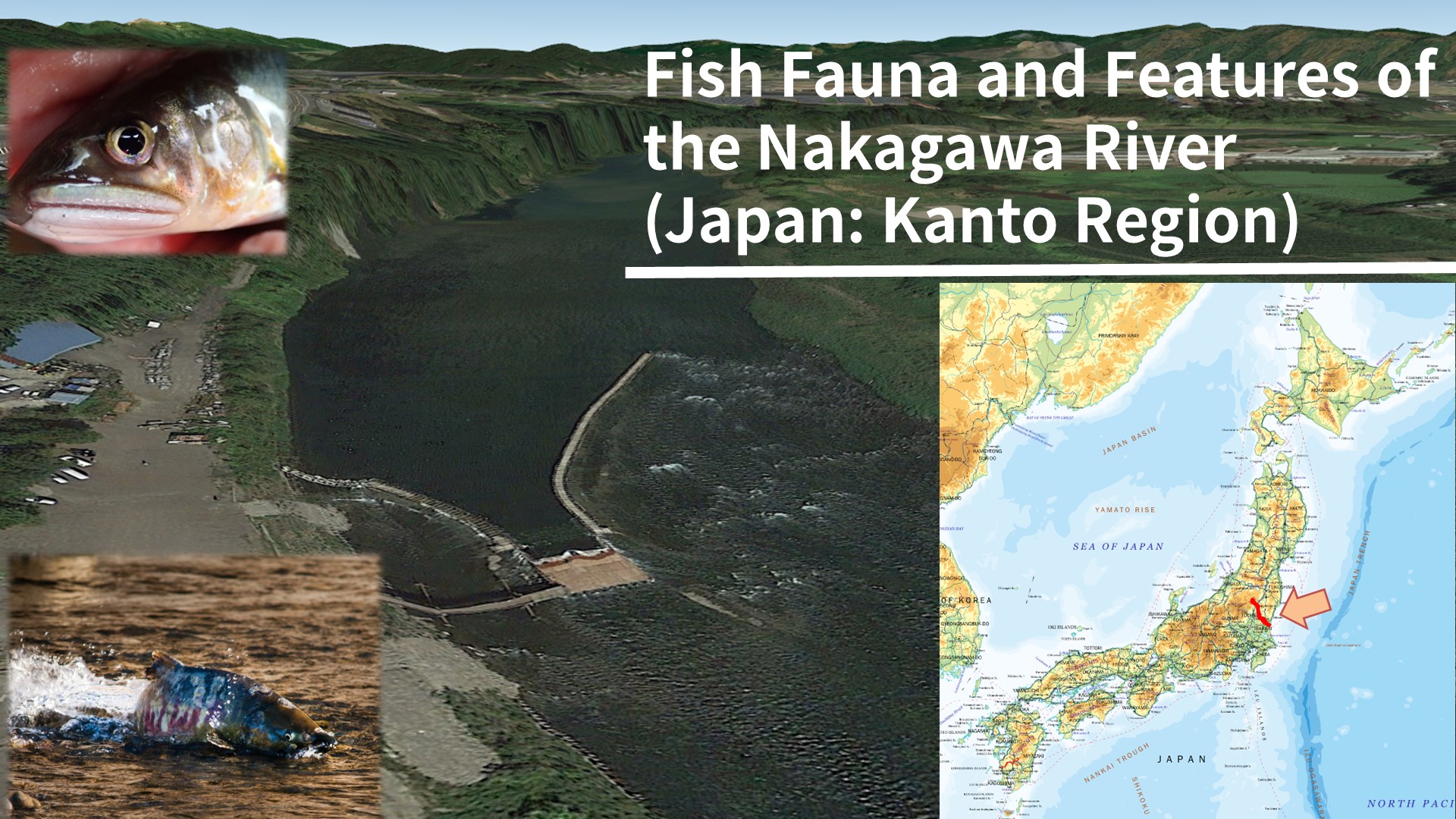In this article, I will introduce Japanese rivers through the latest list of fish species and geographical characteristics, focusing on the Nakagawa River in the Kanto region.
If you are a traveler to Japan with an interest in rivers and fish, I recommend visiting the Nakagawa River in the Kanto region. The Nakagawa stretches for 150 kilometers, originating in Tochigi Prefecture and flowing into the Pacific Ocean in Ibaraki Prefecture. It is the 19th longest river in Japan and the third longest in the Kanto region. With a source elevation of 1,750 meters, it features rapid streams, unlike many continental rivers. Accessible by train and bus from Tokyo, this river offers a premier experience of the relationship between people and river fish. In the Nakagawa, you can encounter natural sweetfish (ayu) and salmon. It also presents an interesting mix of fish species, blending northern and southern varieties. Let’s delve into the Nakagawa River in this edition.
→ Please refer to this site for information about fish throughout Japan.
1.Fish Fauna
According to a national environmental survey on Japanese rivers, the Nakagawa River was home to 72 fish species in 2016 and 91 species in 2021. A distinctive feature of the Nakagawa is the coexistence of species like those of the Salmonidae family, which are primarily found in northern areas, with species like those of the Cyprinidae and Gobiidae families, more common in southern regions. Particularly noteworthy is one of its tributaries, Lake Hinuma, known as the southern limit for herring.
Due to Japan’s elongated shape stretching from north to south, the Nakagawa lies at the boundary between northern and southern fish species, being at the very center of this boundary. In recent years, there has been a noticeable shift in this boundary, with a decline in northern species like salmon, possibly due to global warming. Simultaneously, there’s an influx of southern and non-native species, which is likely due to human activities, as fish cannot naturally traverse long distances over land. Therefore, it seems the distribution boundary is shifting due to two factors: global warming and human-mediated biotic movement.
Thus, the Nakagawa River may be seen as a litmus test, sensitively reflecting changes in the composition of fish species. While there is a hope for stability, the reality appears to be less straightforward. The future trends of this river will undoubtedly continue to be of interest.


The List of Freshwater Fish Species in the Nakagawa River
| No. | Family | English Name | Species | Life Cycle | Origin Status | 2016 | 2021 |
| 1 | Petromyzontidae | Lampreys | Lethenteron sp.N and/or sp.S | Fr | Native | 〇 | 〇 |
| 2 | Dasyatidae | Stingrays | Hemitrygon akajei | E | Native | 〇 | |
| 3 | Elopidae | Tenpounders | Elops hawaiensis | E | Native | 〇 | |
| 4 | Anguillidae | Eels | Anguilla japonica | M | Native | 〇 | 〇 |
| 5 | Clupeidae | Herrings | Sardinella zunasi | E | Native | 〇 | 〇 |
| 6 | Konosirus punctatus | E | Native | 〇 | 〇 | ||
| 7 | Cyprinidae | Carps and Minnows | Cyprinus carpio | Fr | Intorduced | 〇 | 〇 |
| 8 | Carassius cuvieri | Fr | Non-indigenous | 〇 | 〇 | ||
| 9 | Carassius sp. | Fr | Native | 〇 | 〇 | ||
| 10 | Tanakia lanceolata | Fr | Native | 〇 | |||
| 11 | Tanakia limbata | Fr | Non-indigenous | 〇 | |||
| 12 | Acheilognathus melanogaster | Fr | Native | 〇 | 〇 | ||
| 13 | Acheilognathus tabira erythropterus | Fr | Native | 〇 | |||
| 14 | Rhodeus ocellatus ocellatus | Fr | Intorduced | 〇 | 〇 | ||
| 15 | Opsariichthys platypus | Fr | Native | 〇 | 〇 | ||
| 16 | Candidia temminckii | Fr | Non-indigenous | 〇 | 〇 | ||
| 17 | Candidia sieboldii | Fr | Non-indigenous | 〇 | 〇 | ||
| 18 | Rhynchocypris lagowskii steindachneri | Fr | Native | 〇 | |||
| 19 | Pseudaspius brandtii maruta | M | Native | 〇 | 〇 | ||
| 20 | Pseudaspius hakonensis | Fr | Native | 〇 | 〇 | ||
| 21 | Pseudorasbora parva | Fr | Native | 〇 | 〇 | ||
| 22 | Gnathopogon elongatus elongatus | Fr | Non-indigenous | 〇 | 〇 | ||
| 23 | Pseudogobio esocinus | Fr | Native | 〇 | 〇 | ||
| 24 | Abbottina rivularis | Fr | Non-indigenous | 〇 | 〇 | ||
| 25 | Hemibarbus barbus | Fr | Native | 〇 | 〇 | ||
| 26 | Squalidus chankaensis biwae | Fr | Non-indigenous | 〇 | 〇 | ||
| 27 | Cobitidae | Loaches | Misgurnus anguillicaudatus | Fr | Native | 〇 | 〇 |
| 28 | Misgurnus dabryanus | Fr | Intorduced | 〇 | 〇 | ||
| 29 | Cobitis sp. BIWAE type C | Fr | Native | 〇 | 〇 | ||
| 30 | Nemacheilidae | Stone Loaches | Lefua echigonia | Fr | Native | 〇 | 〇 |
| 31 | Bagridae | Bagrid Catfishes | Tachysurus tokiensis | Fr | Native | 〇 | 〇 |
| 32 | Siluridae | Sheatfishes | Silurus asotus | Fr | Native | 〇 | 〇 |
| 33 | Plotosidae | Eeltail catfish | Plotosus japonicus | E | Native | 〇 | |
| 34 | Osmeridae | Smelts | Hypomesus nipponensis | M | Native | 〇 | 〇 |
| 35 | Plecoglossidae | Ayu or Sweetfish | Plecoglossus altivelis altivelis | M | Native | 〇 | 〇 |
| 36 | Salangidae | Icefishes or Sweetfish | Salangichthys microdon | M | Native | 〇 | 〇 |
| 37 | Salangichthys ishikawae | M | Native | 〇 | |||
| 38 | Salmonidae | Salmon and Trout | Salvelinus leucomaenis | Fr | Native | 〇 | 〇 |
| 39 | Oncorhynchus keta | M | Native | 〇 | |||
| 40 | Oncorhynchus masou masou | M | Native | 〇 | 〇 | ||
| 41 | Mugilidae | Mullets | Mugil cephalus cephalus | E | Native | 〇 | 〇 |
| 42 | Planiliza lauvergnii | E | Native | 〇 | |||
| 43 | Poeciliidae | Livebearers | Gambusia affinis | Fr | Intorduced | 〇 | |
| 44 | Adrianichthyidae | Ricefishes | Oryzias latipes | Fr | Native | 〇 | 〇 |
| 45 | Hemiramphidae | Halfbeaks | Hyporhamphus intermedius | E | Native | 〇 | |
| 46 | Hyporhamphus sajori | E | Native | 〇 | |||
| 47 | Platycephalidae | Flatheads | Platycephalus sp.2 | E | Native | 〇 | 〇 |
| 48 | Lateolabracidae | Asian Seabasses | Lateolabrax japonicus | E | Native | 〇 | 〇 |
| 49 | Centrarchidae | Sunfishes | Lepomis macrochirus macrochirus | Fr | Intorduced | 〇 | 〇 |
| 50 | Micropterus salmoides | Fr | Intorduced | 〇 | 〇 | ||
| 51 | Micropterus dolomieu dolomieu | Fr | Intorduced | 〇 | 〇 | ||
| 52 | Carangidae | Jacks and Pomanos | Scomberoides lysan | E | Native | 〇 | |
| 53 | Caranx sexfasciatus | E | Native | 〇 | 〇 | ||
| 54 | Caranx ignobilis | E | Native | 〇 | |||
| 55 | Leiognathidae | Ponyfishes | Nuchequula nuchalis | E | Native | 〇 | |
| 56 | Gerreidae | Mojarras | Gerres equulus | E | Native | 〇 | |
| 57 | Haemulidae | Grunts | Plectorhinchus cinctus | E | Native | 〇 | |
| 58 | Sparidae | Porgies | Rhabdosargus sarba | E | Native | 〇 | |
| 59 | Acanthopagrus schlegelii | E | Native | 〇 | 〇 | ||
| 60 | Acanthopagrus latus | E | Native | 〇 | |||
| 61 | Sillaginidae | Sillagos or Whiting | Sillago japonica | E | Native | 〇 | |
| 62 | Embiotocidae | Surfperches | Ditrema temminckii temminckii | E | Native | 〇 | |
| 63 | Teraponidae | Teraponids | Terapon jarbua | E | Native | 〇 | 〇 |
| 64 | Rhynchopelates oxyrhynchus | E | Native | 〇 | 〇 | ||
| 65 | Kuhliidae | Aholeholes | Kuhlia marginata | E | Native | 〇 | |
| 66 | Cottidae | Sculpins | Cottus pollux | Fr | Native | 〇 | 〇 |
| 67 | Cottus reinii | M | Native | 〇 | 〇 | ||
| 68 | Ocynectes maschalis | E | Native | 〇 | |||
| 69 | Pseudoblennius cottoides | E | Native | 〇 | |||
| 70 | Pholidae | Gunnels | Pholis nebulosa | E | Native | 〇 | |
| 71 | Eleotridae | Sleepers | Eleotris oxycephala | Fr | Native | 〇 | 〇 |
| 72 | Gobiidae | Gobies | Luciogobius guttatus | E | Native | 〇 | 〇 |
| 73 | Eutaeniichthys gilli | E | Native | 〇 | |||
| 74 | Leucopsarion petersii | Fr | Native | 〇 | |||
| 75 | Acanthogobius flavimanus | E | Native | 〇 | 〇 | ||
| 76 | Acanthogobius lactipes | E | Native | 〇 | 〇 | ||
| 77 | Sicyopterus japonicus | M | Native | 〇 | 〇 | ||
| 78 | Mugilogobius abei | E | Native | 〇 | 〇 | ||
| 79 | Pseudogobius masago | E | Native | 〇 | |||
| 80 | Tridentiger trigonocephalus | E | Native | 〇 | |||
| 81 | Tridentiger bifasciatus | E | Native | 〇 | 〇 | ||
| 82 | Tridentiger brevispinis | Fr | Native | 〇 | 〇 | ||
| 83 | Redigobius bikolanus | E | Native | 〇 | |||
| 84 | Rhinogobius nagoyae | M | Native | 〇 | 〇 | ||
| 85 | Rhinogobius fluviatilis | M | Native | 〇 | 〇 | ||
| 86 | Rhinogobius similis | M | Native | 〇 | |||
| 87 | Rhinogobius sp.OR unidentified | M | Native | 〇 | 〇 | ||
| 88 | Glossogobius olivaceus | E | Native | 〇 | |||
| 89 | Favonigobius gymnauchen | E | Native | 〇 | 〇 | ||
| 90 | Gymnogobius petschiliensis | M | Native | 〇 | 〇 | ||
| 91 | Gymnogobius urotaenia | M | Native | 〇 | 〇 | ||
| 92 | Gymnogobius heptacanthus | E | Native | 〇 | |||
| 93 | Gymnogobius macrognathos | E | Native | 〇 | |||
| 94 | Chaenogobius annularis | E | Native | 〇 | |||
| 95 | Chaenogobius gulosus | E | Native | 〇 | |||
| 96 | Channidae | Snakeheads | Channa argus | Fr | Intorduced | 〇 | |
| 97 | Paralichthyidae | Large tooth Flounders | Paralichthys olivaceus | E | Native | 〇 | 〇 |
| 98 | Pleuronectidae | Righteye Flounder | Platichthys stellatus | E | Native | 〇 | |
| 99 | Platichthys bicoloratus | E | Native | 〇 | 〇 | ||
| 100 | Cynoglossidae | Tonguefishes | Paraplagusia japonica | E | Native | 〇 | |
| 101 | Tetraodontidae | Pufferfish | Takifugu flavipterus | E | Native | 〇 | |
| 102 | Takifugu alboplumbeus | E | Native | 〇 | 〇 | ||
| Total | 40 families | 102 Species | 72 | 91 |
** : While some species have been subdivided, the names of species have been retained as they were previously for comparison with past data.
*** : Salvelinus leucomaenis and Oncorhynchus masou masou are included in the record because the author has confirmed their perennial habitat in the upper reaches of the survey area.
****: Classification of Life Cycles
・ Freshwater: Species that can spend their entire life in freshwater.
・ Migratory: Species that must migrate between freshwater and saltwater during their lifetime.
・ Euryhaline: Species that primarily inhabit brackish or saltwater, but may also venture into freshwater.
However, since there are species with intermediate characteristics, such species have been categorized at the author’s discretion.
2. Features as a RIver
The Nakagawa River is a clear stream blessed with the natural beauty of the Kanto region. Its upper reaches lie within the Nikko National Park, while the middle course is protected as the Nakagawa Prefectural Nature Park. Despite flowing through the heavily urbanized Kanto region, this area maintains its natural environment, supporting a rich ecosystem.
The river basin is abundant with fish species such as sweetfish (ayu) and salmon, and their upstream migration is well-known. Particularly, the local fishing of ayu and salmon is a highlight, with grilled ayu being a popular gourmet attraction for tourists along the middle course of the river from Tochigi to Ibaraki Prefecture in early summer. Moreover, visitors can experience ayu fishing and observe various other fish species in activities like ‘nagashi’ (as introduced in this video).
In Sarado, Otawara City, Tochigi Prefecture, there is a prefectural fisheries experimental station dedicated to freshwater fish research. Adjacent to this facility is the Nakagawa Aquatic Park, one of the leading freshwater aquariums in the country, where you can learn about the freshwater fish of the Nakagawa River. Visiting this region offers an in-depth understanding of the rich nature and ecosystem of the Nakagawa River.
3. Conclusion
The main points of the Naka River summarized in this article are as follows.
It is a really nice river and you should come and enjoy it. I will definitely be there at least once this year.
a. It reflects the diverse aquatic biodiversity of the region, with a unique mix of fish species from northern and southern Japan.
b. Despite its proximity to urban areas, the river ecosystem is well preserved, with some parts protected by national and prefectural parks. They also have a close relationship with people. In particular, the traditional fishing method, ayu fishing by Yana, is worth seeing.
c. The river is a likely environmental indicator of changes in fish populations due to global warming and anthropogenic influences.
See you soon.




コメント